Introduction
You’ve decided you want to plant a tree with white flowers in your garden. Congratulations! Not only are these trees beautiful, but they also provide vital benefits to the environment. If you’re looking to add some eye-catching beauty to your landscape, these trees are a great option!
In this guide, we’ll walk you through everything you need to know about different types of landscaping trees with white flowers. We’ll cover everything from choosing the right spot to watering and fertilizing your tree. We hope you find this guide helpful!
Why Plant Trees With White Flowers?
You might be wondering, “Why plant a tree with white flowers?” There are actually a few reasons why this might be a good idea.
For one, trees with white flowers can add a touch of elegance to any garden or landscape. They can also provide shade and privacy, and their fragrant flowers can add a lovely scent to the air.
But perhaps most importantly, trees with white flowers can help attract pollinators like bees and butterflies. This is important because these insects are essential for the health of our ecosystem. So by planting a tree with white flowers, you’re not only adding beauty to your surroundings, but you’re also doing your part to help the environment.
How to Care for Trees With White Flowers
Once you’ve chosen a tree with white flowers, it’s important to know how to care for it properly. Here are a few tips:
1. Water regularly. Trees with white flowers need plenty of water to stay healthy, so make sure to water them regularly, especially during the summer months.
2. Fertilize regularly. A good fertilizer will help your tree grow big and strong, so make sure to fertilize it at least once a year.
3. Pruning. There are ways you can prune a tree when it is young so that it will grow in to a tree of manageable size. Pruning young trees to manage their height is better than attempting to lower the height of a mature tree.
List of Trees With White Flowers
- Chinese Fringe Tree (Chionanthus virginicus)
- Franklin Tree (Franklinia alatamaha)
- California Buckeye (Aesculus californica)
- Yoshino cherry trees (Prunus x yedoensis)
- Japanese crape myrtle (Lagerstroemia fauriei)
- Flowering dogwood (Cornus florida)
- American Elderberry (Sambucus canadensis)
- Callery pear (Pyrus calleryana)
- Japanese loquat (Eriobotrya japonica)
- Japanese apricot (Prunus mume)
- Star Magnolia trees ( Magnolia stellata)
- White floss silk tree (Ceiba insignis)
- Ivory Silk Japanese Lilac Tree (Syringa reticulata)
- Serviceberry (Amelanchier ssp)
- Black Chokeberry tree (Aronia melanocarpa)
- Japanese snowbell (Styrax japonicus)
- Horse Chestnut (Aesculus hippocastanum)
- Natal Plum (Carissa macrocarpa)
- Northern Catalpa (Catalpa speciosa)
- Royal White Redbud (Cercis canadensis ‘Royal White‘)
- Washington Hawthorn (Crataegus populifolia)
- Buttonbush (Cephalanthus occidentalis)
- Carolina Silverbell ((Halesia tetraptera; formerly H. carolina)
- American yellowwood tree (Cladrastis kentukea)
- California dogwood tree (Cornus nuttallii)
- White rose of Sharon tree (Hibiscus syriacus)
- Natchez crape myrtle tree (Lagerstroemia x “Natchez“)
- Sweet tea Gordlinia tree (× Gordlinia grandiflora)
- White Weeping cherry tree
- Japanese lilac tree ( Syringa reticulate)
Common Fringe Tree

The common fringe tree also called old man’s beard, reaches a height of 12 to 20 feet with an equal spread at maturity. Fringe trees are generally slow-growing, increasing in height by about 6 to 10 inches each year. They usually require little pruning, since they have a naturally strong and pleasing branch structure.
It covers itself in drooping, 6-inch-long clusters of small white, fragrant flowers from May through June, with male and female flowers on separate trees. If you grow both a male and female tree, flowers on the female tree produce small fruits resembling bluish-black olives that attract birds and wildlife.
Also Read: Different Types of Trees With Pink Flowers
Franklin Tree

The Franklin tree is a deciduous tree that grows several trunks but can be trained into a single-trunk tree 30 feet tall. The glossy green leaves grow 4 to 6 inches long and turn orange and red during the fall. The 3-inch-wide, white, strawberry plant-like flowers open in late summer, filling the landscape with fragrance. It takes the Franklin tree six to seven years to flower when planted from seed.
Grown for its handsome flowers, showy fall foliage, and historical interest, Franklin Tree makes a stunning small specimen tree for the garden. However, it can be tricky to establish because it requires precise moisture levels, well-drained, nutrient-rich acidic soils, and protection from environmental stress.
California buckeye

California buckeye also called horse chestnut, is a large deciduous shrub or small tree that grows wild in the western United States. The California buckeye tree grows approximately 10 to 20 feet tall with a 30-foot spread. Its low branches and multiple trunks are covered with silvery bark, and it has a naturally symmetrical, rounded form.
It grows bunches of five to seven leaves that have serrated edges and showy, fragrant, white-to-pale rose flowers in the spring. The flowers yield a pear-shaped fruit containing light brown nuts. If the weather is hot and dry, it drops its leaves in July and August, but if it gets enough rain, it keeps its leaves into autumn. It is useful as a landscape ornamental and helps bind soil on steep slopes and the banks of rivers and streams.
Yoshino Cherry Tree

Yoshino cherry trees (Prunus x yedoensis) grow 25 to 40 feet high and 20 to 30 feet wide, in a soft rounded form. The trees produce billowing clusters of white blossoms in late spring, followed by glossy green leaves that turn yellow or gold in the fall.
Yoshino cherry trees are considered moderate to fast growers, especially in their youth. Young trees may reach 10 to 15 feet in as little as three or four years. They may also have a trunk diameter of up to 3 inches at this same age. This rapid juvenile growth rate slows a bit as the tree ages, but it may still grow an additional 3 to 4 feet per year throughout its lifetime.
White Flowering Dogwood

The white flowering dogwood (Cornus florida) is a common deciduous tree occurring throughout the eastern half of the United States. It is the state tree of Virginia and state flower of North Carolina. It is a common ornamental landscape tree that offers something nice throughout the year. The tree provides showy white flowers in spring, rich green foliage in summer, bright red leaves in fall and red berries relished by birds and animals all winter.
The flowering dogwood occurs as a single or multi-trunked tree. As an understory and woodland-edge tree, it grows to an average 20 to 25 feet tall and about 20 to 25 feet in spread. It has multi-layered branches. In winter it can be identified by the large, flattened floral buds at the tips of its twigs. Branches droop as the tree grows and may require pruning to allow pedestrian or vehicle traffic.
Also Read: Landscaping Trees With Red Flowers
American elderberry

American elderberry is a multi-stemmed deciduous shrub of loose open habit with arching, spreading branches, clothed in a lush foliage of sharply serrated, bright green leaves composed of 7 leaflets. It is commonly seen along streambanks and roadsides and in moist woodlands and thickets throughout eastern North America.
In early to mid summer, a profusion of lemon-scented white flowers appear in large flat clusters. They give way to black elderberry fruits later in the season. Attractive to birds, the fruits may be used to make jams, jellies and elderberry wine. Good shrub for naturalized areas where suckering spread may be appreciated. Elderberries typically grow to about 12 feet high, but they tolerate pruning to a smaller size.
Callery pear
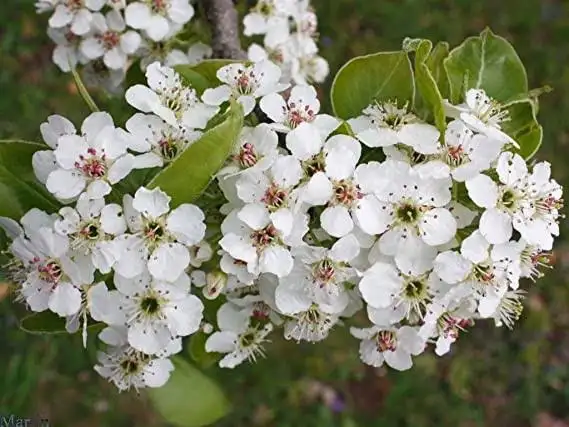
Callery pear also referred to as Ornamental pears are deciduous and have medium to dark green ovate leaves and furrowed dark brown to light green bark. The leaves of all varieties produce striking fall color in shades that include red, bronze and purple. Showy white flowers, the signature feature of the ornamental pear tree, blossom in the spring or winter. In the summer, ornamental pear trees produce small, pome-type fruit, no bigger than half an inch in diameter.
When immature, pears are more pyramidal in shape, growing upwards more than they do outwards and tapering at the top. Older trees, however, have a more rounded crown and branches that angle up instead of growing almost straight up. Young pear trees need help establishing their spreading habit through pruning, though with age and maturity trees will maintain a more rounded shape naturally.
Japanese loquat
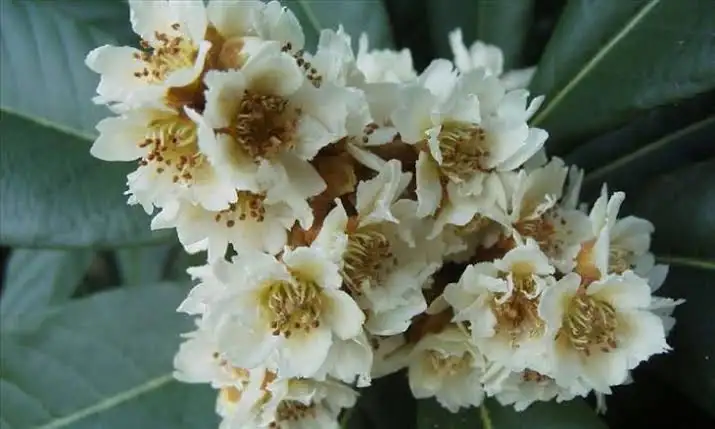
Japanese loquats called the Japanese medlar and the Japanese plum, loquats are commonly grown as ornamental shrubs or edible fruit crop trees in home landscapes. They are small, bushy evergreen trees or large, spreading shrubs with short trunks, rounded canopies and fuzzy twigs.
They feature large, leathery, deep green leaves and clusters of small, white blossoms that bloom from October through February. The sweetly fragrant flowers give way to small yellow fruit that ripens from spring through the early summer. Mature trees can reach up to 30 feet in height, but most only grow to about 10 feet tall.
Also Read: Different Types of Trees With Brilliant Fall Color
Japanese apricot
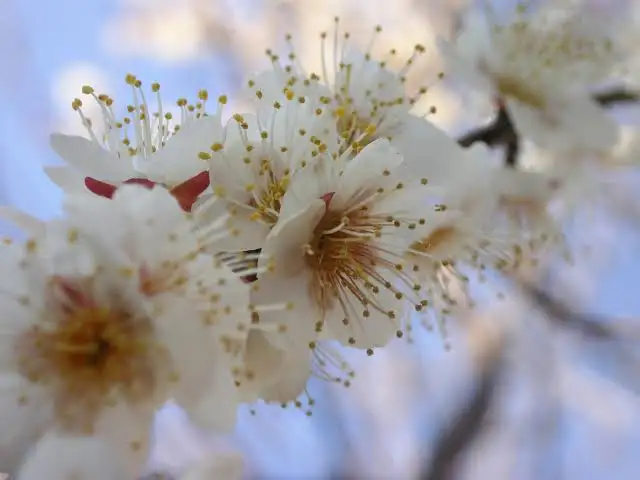
Prunus mume, commonly known as Japanese apricot or Japanese flowering apricot, is one of the longest-lived flowering fruit trees. It is admired for its twisted, gnarled trunk and limbs as it ages. Japanese apricot trees will grow in a wide range of well-drained, slightly acidic soils. It grows rich green foliage on dark green stems in late spring and summer.
Japanese apricot yields beautiful, delicate flowers that flourish in full sun. The flowers have a rich, spicy fragrance. Depending on the cultivar, they have single or double petals and can be pink and red through white, depending on the variety. If your area has late winter frosts and your tree is located in a protected area, the flowers may open early and be killed by a late freeze.
Star Magnolia trees
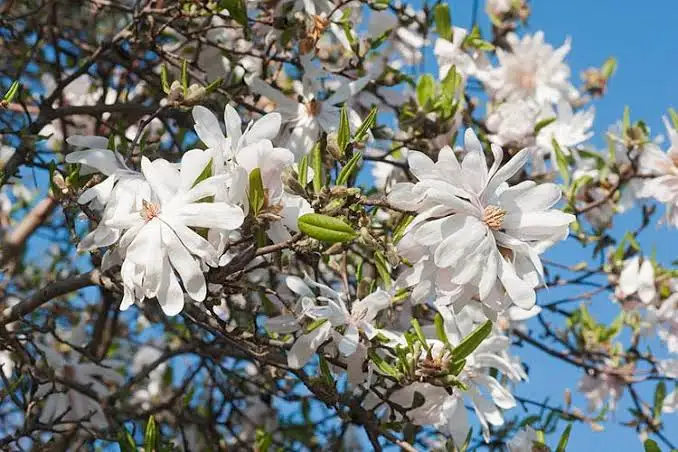
The star magnolia is a shrub-like tree that produces fragrant blossoms that last throughout the spring and into the summer. The flowers blossom to reveal bright white tepals in a star-shaped pattern. These flowers bloom in the beginning of spring and can last until the middle of summer if properly cared for.
The star magnolia tree itself can grow up to 30 feet tall and presents foliage and flowers on several individual trunks that split off from the main trunk a few feet from the ground. The star magnolia is deciduous and loses its leaves in the winter after creating colorful fall foliage. The wood of the star magnolia tree is softer and weaker than other trees of its size and is susceptible to damage, even from wind.
White floss silk tree
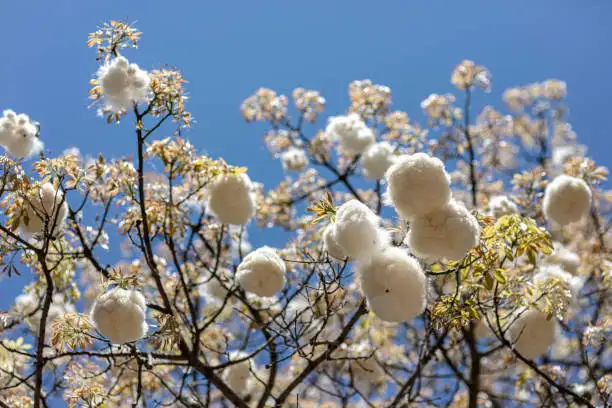
The white floss silk tree (Ceiba insignis), also called a drunken tree is an evergreen tree that grows up to 50 feet tall and has large, five-petaled star-shaped white or pale yellow flowers. The leaves are light green and palmate in a high, oval canopy. The tree’s bark is light green or gray and often has spines or thorns covering the bark.
Its trunk is bottle-shaped, generally bulging in its lower third, measuring up to 2 metres (7 ft) in girth. The trunk is also studded with thick, sharp conical prickles which deter wild animals from climbing the trees. As a deciduous tree, it is completely bare of leaves and flowers during the winter months, especially when growing outside of its native South America habitat.
Also Read: Types of Trees With White Bark
Japanese Tree Lilac
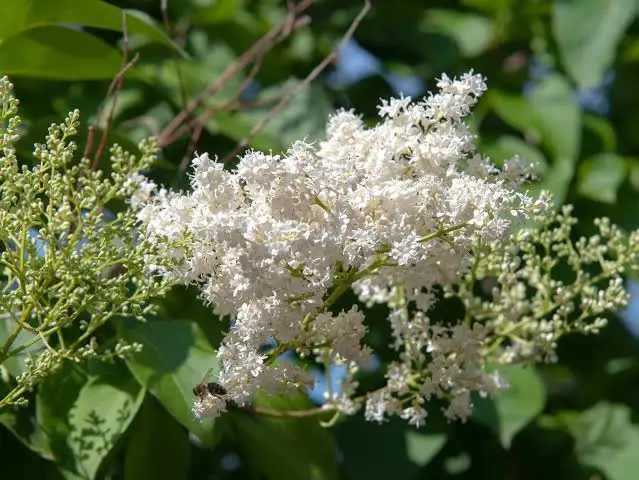
Japanese Tree Lilac is a large shrub or small tree with an oval to rounded crown. In early summer, a profusion of huge clusters packed with fragrant, tiny creamy-white flowers adorn the tree. Flowering begins at a young age on this sturdy, compact tree. The blossoms give way to loose clusters of tan capsules that persist well into the winter months. The erect branches are clothed in lanceolate to ovate, dark green leaves that remain attractive in summer.
Equally handsome is the lustrous, reddish-brown exfoliating bark with horizontal lenticels, reminiscent of cherry bark. Drought resistant and free of pests and disease, this Japanese Tree Lilac is attractive as a small landscape tree or large shrub.
Serviceberry

Known by many names including Juneberry and shadbush, serviceberry (Amelanchier spp.) trees are grown for their year-long ornamental interest provided by their flowers, leaves and berries. In the wild, serviceberries can grow up to 40 feet tall. It generally takes the trees five to 10 years to reach a height of 9 to 10 feet. In urban settings they’re usually maintained as shrubs or small trees.
The deciduous serviceberry shrub boasts fragrant, five-petaled white flowers against a backdrop of dark green leaves in spring and summer, with brilliant yellow, red or orange leaves in the fall. The berries mature from green and yellow to red, purple and black, and tend to reach maturity in June, hence the name Juneberry. In the fall, serviceberries are enjoyed for their impressive foliage, which ranges from yellow to orange and red.
Black chokeberry

Black chokeberry is a deciduous shrub that grows in an upright and fairly rounded shape. Its glossy, dark green leaves are around 1 to 3 inches long and either lanceolate or elliptical in shape. The foliage turns red to reddish-purple in the fall, providing striking color to the landscape before dropping off the plant for winter.
In spring, a profusion of fragrant, whitish pink flowers are borne in loose clusters. Rich in nectar, they are of great interest to early butterflies, hummingbirds and pollinators. The flowers are followed in late summer by abundant, glossy, pendulous clusters of black berries that persist throughout fall and well into winter. Songbirds and upland gamebirds do enjoy them in winter months, as do many species of small mammals. Ornamental and adding winter interest to the landscape, they also make tasty jams and jellies.
Also Read: Different Types of Flowering Trees For Landscaping
Japanese snowbell
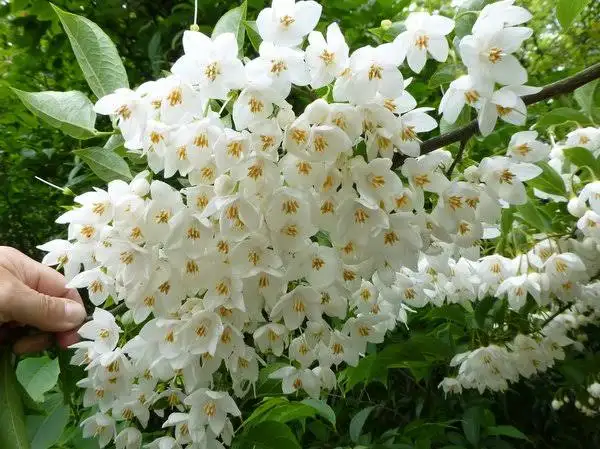
Japanese snowbell (Styrax japonicus) is a small tree with the horizontal branches making a nice canopy. From late spring to early summer, clusters of bell-shaped, white or pinkish flowers dangle from the ends of its horizontal branches. The subtly fragrant blooms show up well against its glossy green leaves. The branches’ contrasting, gray and orange bark becomes visible when the leaves drop in fall. It reaches a mature size between 15 and 20 feet.
Japanese snowbell trees are easy to care for and they are perfect for moderate sized, low maintenance beautifying in places such as parking lot islands and along property borders.
Horse Chestnut
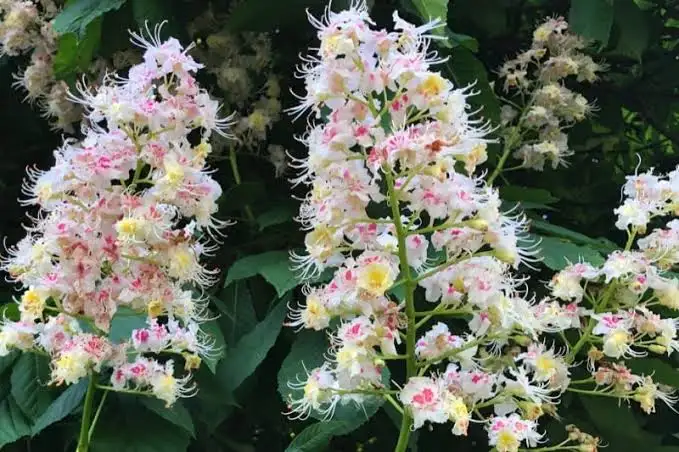
Like true chestnuts, the horse chestnut tree bears serrated leaves. However, the tip of the leaf bulges out into a round end topped with a very thin taper. Its leaves are also compound, with five to seven leaflets emanating from a single stem like spokes on a wheel. The leaf stems and buds appear directly opposite each other on horse chestnut twigs, which will look coarse and pitted on close examination.
The tree’s large, upright clusters of pink or white flowers bloom in late spring and can be five to 12 inches tall. They are followed up by spiny green seedpods in the fall. Along with their beautiful flowers and seedpods, the horse chestnut tree also exhibits interesting bark and twisted limbs.
Natal plum

The Natal plum is a beautiful tropical shrub grown mostly as a flowering landscape specimen, but also for its small fruits, which taste like cranberries and are used in jams and jellies. Like Indian hawthorn, Natal plumb is used frequently in commercial landscapes in warmer climates, where its pretty white star-shaped flowers and fragrance are highly prized.
The plant blooms most profusely in early spring, but produces a few flowers throughout the year. The flowers bloom singly or in small terminal cymes at the end of the branches. The flowers are white and fragrant. The 5 petals are twisted to the right. Some plants bear flowers that are functionally male, larger than normal and with larger anthers, and stamens much longer than the style. Functionally female flowers have stamens the same length as the style and small anthers without pollen.
Northern Catalpa

Catalpa trees have interesting characteristics that set them apart from other landscape trees. Their large, heart-shaped leaves are a dark, brilliant green and reach 6 to 8 inches wide. And while seeds aren’t often considered a feature of a specimen tree, the catalpa’s pods add visual interest when they grow.
In addition to the leaves and pods, the catalpa grows flowers with panicles of small bell-shaped white blooms with small purple dots and streaks on the inside. Catalpas generally grow to 50 to 65 feet tall and feature either an upright and ovate, rounded or umbrella shape at maturity.
Also Read: Types of White Flowers To Grow Around The Yard
Royal White Redbud

Royal White Redbud is more compact than the typical White Redbud. This Redbud blooms a magnificent display of pure white flower clusters before the deep green, heart shaped leaves appear in the spring. The flowers extend from the trunk to the tips of the branches.
Heart-shaped leaves on this small tree make it an attractive specimen or accent for landscapes. These trees are effective as a single specimen, in groupings, in a shrub border, and especially nice in woodland and naturalized type situations.
Washington hawthorn
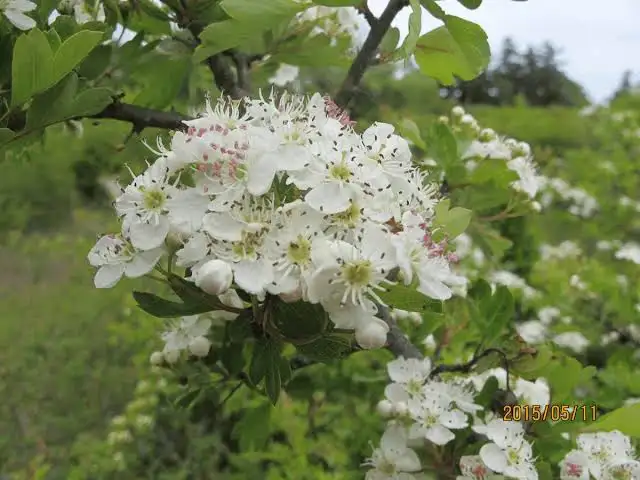
Washington hawthorn trees attain a height of 25 to 35 feet, with a spread also of 25 to 35 feet. They produce attractive white blooms in clusters, from late spring to early summer. These flowers, known for their distinctive odor, yield to first green and then red berries that persist throughout winter. These berries are a favorite snack of wild birds, such as cedar waxwings.
The bark of the Washington hawthorn tree is pretty enough to add further visual interest to the winter landscape, and its branches bear thorns. Its summer leaves are a shiny, dark green; its fall foliage ranges in color from orange to red.
Buttonbush

Buttonbush also referred to as Honey-bells is often lauded for its utility rather than its beauty. Its unique-looking pin cushion-like balls of white, fragrant flowers that appear in mid- to late summer draw the attention of pollinators and people alike. This wetland shrub can be found in low-lying areas, swamps, marshes, bogs, and wetlands, and along the edges of ponds, streams, and rivers.
Buttonbush typically grows up to 6 to 8 feet tall and wide, but can attain a height of 12 to 15 feet with an equal spread. While its open, irregular form has been described as disheveled or unkempt, buttonbush can look more attractive by pruning lanky, wayward branches to outward growing side shoots.
Carolina Silverbell
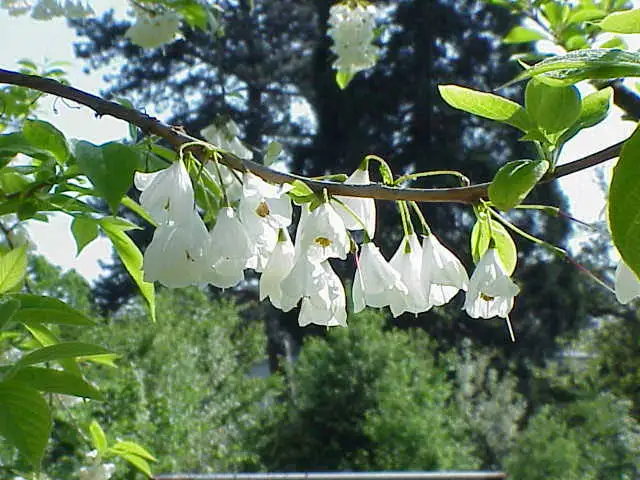
Also known as Silver Bell, Halesia carolina is a small, fast-growing, deciduous tree with an open, rounded crown. It gets its common name of snowdrop tree from the clusters of white, dangling, bell-shaped flowers borne between March and May. These appear with the light green, oval leaves, which turn yellow in autumn. The flowers are followed by light green, four-winged fruits, which persist on the tree well into winter.
Silverbells can make a dazzling springtime display when used beside a patio or along the edge of a woodland border. Both species of silverbell have a medium growth rate, and grow best in part-shade, as they are naturally understory trees.
American yellowwood
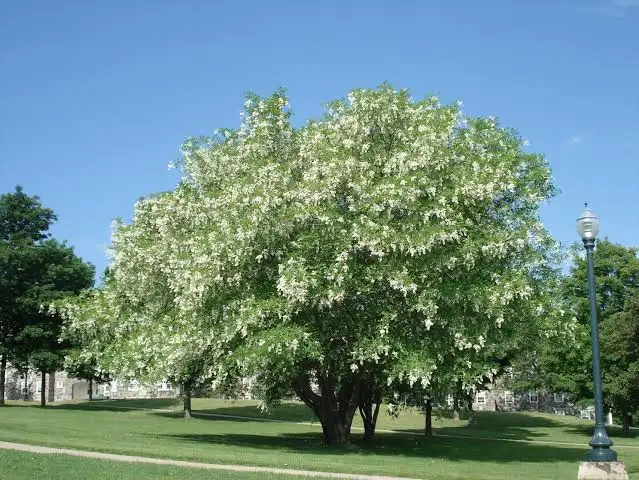
American yellowwood is a nice medium-sized landscape tree with bright green foliage and smooth gray bark. A low-branching species, yellowwood has a rounded crown and grows 30 to 50 feet tall with a spread equal to its height. The pealike flowers, which are more abundant in alternate years, hang in strings 8 to 14 inches long.
Lovely chartreuse leaves distinguish this tree in the spring, when it is also noted for its flowers, and in summer, when they contrast with darker greens in the garden. Yellowwood also has a handsome, silvery, sinuous bark that becomes prominent in the winter and as it matures. The long, drooping clusters of white flowers that hang on this tree are among the most beautiful to be found.
Cornus nuttallii
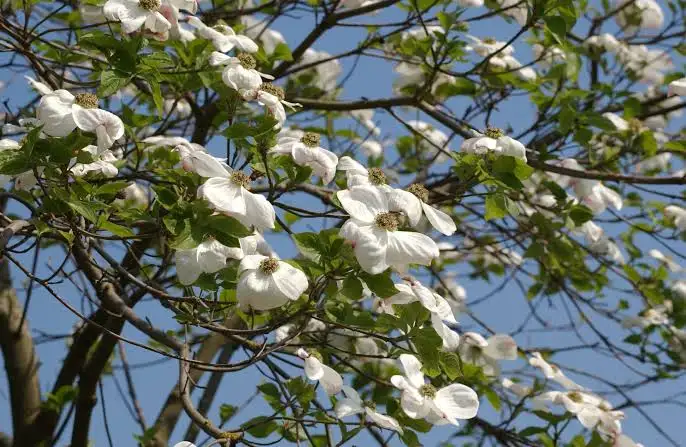
The California dogwood tree also called Pacific dogwood, Western dogwood and mountain dogwood, is a handsome North American native often grown as an ornamental tree in coastal regions west of the Cascades.
The deciduous leaves start off dark green and shiny, but turn red or gold in the autumn. Mature California dogwood trees reach about 50-foot tall with similar spreads. Smooth and thin young bark develops thick ridges with maturity, giving the trunk an attractive, textured appearance.
The showy, fragrant flowers of the California dogwood first appear in spring and usually continue blooming into early summer. Each flower features six creamy-white, petal-like bracts surrounding a green center. The flowers give way to clusters of vibrant red, berry-like fruits called drupes.
Also Read: Types of Weeping Trees For Landscaping Your Home
White rose of Sharon tree
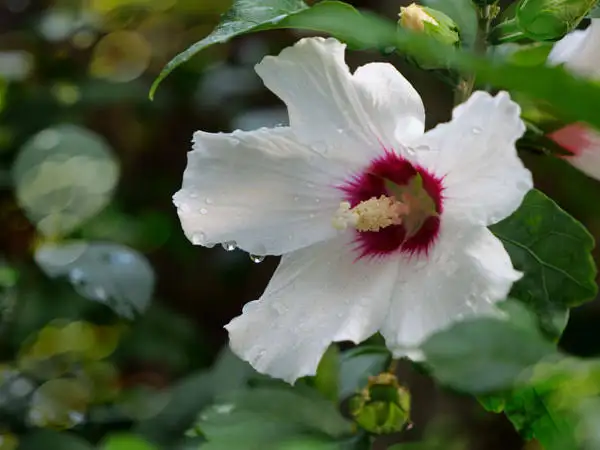
Rose of Sharon is a deciduous, broadleaf ornamental shrub, member of the Hibiscus genus. It’s the national flower of South Korea and appears in the Bible’s Song of Solomon (2:1-2) as a reference to beauty. It is generally an upright-growing shrub that can reach 10 to 12 feet tall with a 6-foot spread.
The medium-green leaves are coarse, up to 3 inches long and have three lobes. The showy flowers are large, typically 3 to 6 inches in diameter, in colors ranging from white to red to violet and blue, with red centers boasting a prominent white stamen. Seed capsules form in the fall and remain through winter. Rose of Sharon attracts hummingbirds and butterflies, and fulfills myriad uses in the landscape, from borders, hedges and screens to single specimen plants.
“Natchez” crepe myrtle

Natchez” crepe myrtles (Lagerstroemia x “Natchez”) are hybrid crepe myrtles prized for their showy white flowers, brilliant fall foliage color, attractive bark and fruit and low maintenance requirements once the plant is established.
A “Natchez” crepe myrtle can become 25 or 30 feet tall when mature, with a spread of 15 to 15 feet. It grows as a naturally spreading shrub, with a wide canopy, and has strong branches with good wind resistance. It should be planted to accommodate its mature size width with at least 15 feet between each shrub. Crape myrtles have a naturally graceful form and look best when pruned lightly.
Sweet tea Gordlinia tree
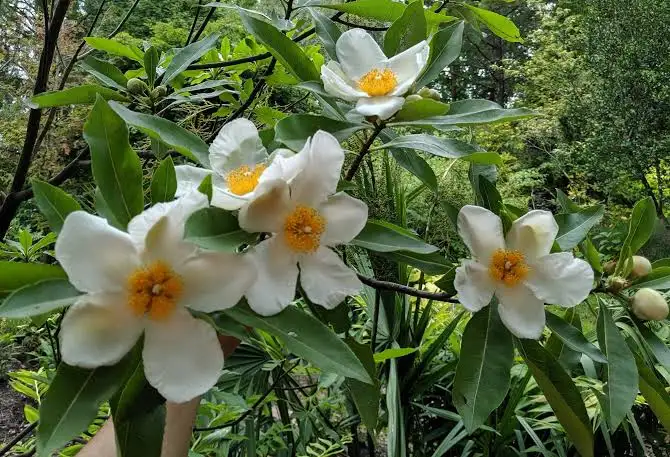
Sweet tea Gordlinia tree commonly known as mountain gordlinia, is an intergeneric hybrid resulting from a controlled cross made between Franklin tree and loblolly bay. This fast-growing hybrid typically grows as a multi-stemmed shrub or small tree to 20 feet (occasionally to as much as 30 feet tall and to 10 feet wide.
Large, partially cupped to flattened, camellia-like flowers each sporting 5 white petals surrounding a showy boss of egg-yolk yellow center stamens, bloom from July to September. Narrow, lanceolate-elliptic leaves with serrulate margins are dark green above and pale green beneath. Leaves are semi-evergreen, but usually acquire some shades of red and orange in fall.
Conclusion
From the Bradford Pear to the Yoshino Cherry, there are many different types of trees with white flowers that can be planted in your yard. It’s important to select the right tree for your climate and growing conditions, and to properly care for it once it’s been planted. With the proper care, your tree with white flowers will thrive and provide years of beauty to your landscape.